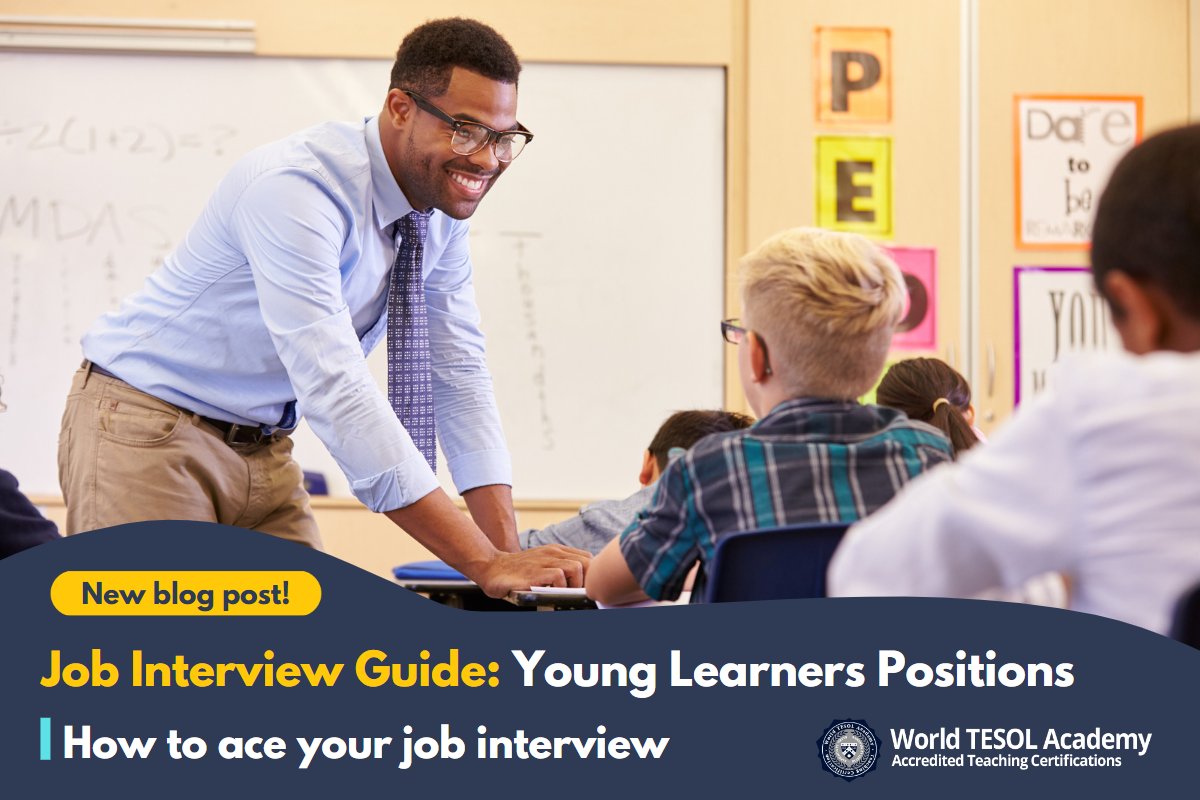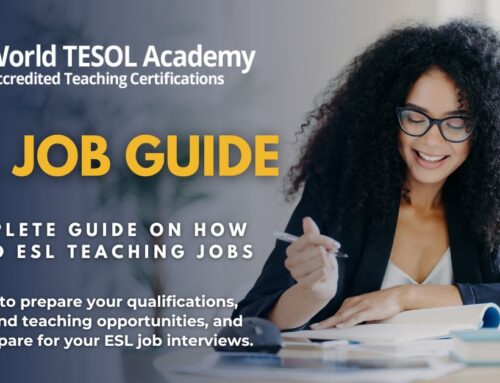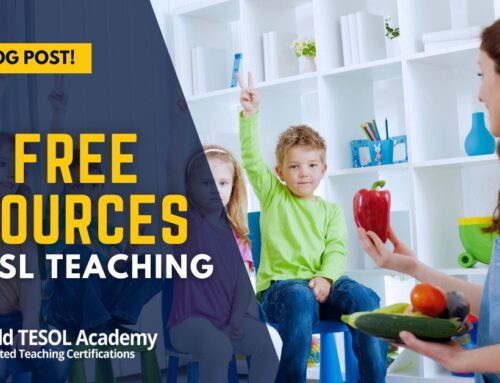
Job Interview Guide: Young Learner Positions
Teaching English to young learners (TEYL) is a popular and rewarding career path that many English teachers decide to explore during their careers.
When interviewing for TEYL positions, it’s common that recruiters may ask you specific TEYL-related questions to check if you possess the right skills needed to teach young learners. In order to ace these questions and land the job, it’s recommended that you prepare a few suitable answers before sitting down for your interview.
Teaching English to young learners can be very different from teaching teenage and adult learners, which makes it extra important that you know how to adapt your teaching methods so that they are suitable for young learners.
To help show potential future employers that possess these necessary skills, it’s good to sit down and spend a little bit of extra time preparing suitable answers to TEYL-related questions that may come up during your job interview.
Whether you’re a seasoned TEYL professional or new to the world of teaching, understanding how to approach these questions and answer them in a professional manner can help you stand out in the interview process and secure your dream job.
In this blog post, we will explore some of the top TEYL interview questions that you may face during your job interviews, as well as tips on how to answer them in a professional way.

💬 “Do you have experience working with children?”
This is one of the most common questions that you’ll receive when interviewing for positions where you’ll be teaching young learners. The recruiter should already have somewhat of an idea about your experience and qualifications in teaching young learners based on your resume.
However, they may still ask you this question to check if what you’ve written in your resume is accurate. It can be a good idea to prepare some examples of situations or settings where you’ve taught young learners before. This is also a good opportunity to show off your passion and drive for teaching.
This way you’ll be able to confidently highlight your qualifications and teaching experience.
Example: “Yes, I have experience working with children both inside and outside the classroom. In terms of my professional experience, I have worked as an English teacher for young learners for the past two years, where I taught young learners between the ages 5-12.
I have also worked with children in non-teaching roles, such as volunteering at summer camps and after-school programs. My main role was to help to plan and lead activities and provide individual support to children who may be struggling.
I truly enjoy working with children and find it rewarding to watch them learn and grow, and I believe that my experience working with children has given me the skills and abilities necessary to be an effective English teacher for young learners.”

💬 “How do you motivate and engage young learners?”
No matter the age of your students, knowing how to motivate and engage them is one of the core skills needed by English teachers. This is especially important when teaching young learners, as they often lack the intrinsic motivational factors that can be found among adult learners.
When answering this question, the focus should be on the techniques and strategies that you use to motivate your students during the learning process, and how you encourage participation and active learning in the classroom.
This can be techniques such as using positive reinforcement, implementing engaging activities, including the student in the decision-making process, or selecting materials that are connected to your students’ interests and experiences.
Example: “As an English teacher for young learners, motivating and engaging my students is one of my top priorities. I believe that by creating a positive and supportive learning environment I’m able to keep my students motivated and engaged.
One way I do this is by incorporating interactive and engaging activities into my lessons, such as games, role-playing exercises, and group projects. These activities can not only make learning fun but can also help my students develop their critical thinking, communication, and collaboration skills.
I also focus on using positive reinforcement and praise to motivate my students. I make sure to acknowledge and celebrate their achievements and provide constructive feedback that encourages their growth and improvement.”
Getting your TEYL certificate: Learn how to teach English to young learners in our accredited 60-hour TEYL specialist course.
In the course, you’ll learn how young learners develop new language skills, as well as powerful techniques and strategies to help make lessons both fun and effective.
If you haven’t enrolled in the course you can do so here:
.

💬 “How would explain X to a young learner?”
In addition to being able to confidently state your qualifications, the recruiter may also wish to see if you are able to practice what you preach. To do this, they may ask you questions that target your English teaching ability.
Not only does this allow them to check if you can think on your feet and adapt to unexpected questions, but most importantly it allows them to check your actual teaching skills.
When answering this type of question, it’s important to first highlight your approach of being patient, using simple language, and engaging the student through interactive and fun activities.
You can then continue by providing an example of the techniques and strategies you would use to teach the new target language.
As you know, teaching consists of so much more than just spoken words. So remember to utilize TPR such as facial expressions, gestures, and other useful teaching skills to show that you are able to explain new knowledge in a fun and interactive way.
Example: “When explaining a new concept to a young learner, I first make sure to use clear and simple language that they can understand.
If I were to explain the concept of verbs to a young learner, I might start by saying that verbs are words that show action or describe what someone or something is doing.
I might then give some examples of common verbs, such as ‘run’, ‘jump’, or ‘sing’, and ask the student to think of some actions that they do. To reinforce the concept, I then ask the student to identify verbs in a sentence or to create their own sentence using a verb.
I also make sure to include teaching aids and techniques that can help my students to further understand the concepts, such as using TPR, pictures and flashcards that illustrate verbs and actions or using realia such as toys or puppets to act out different verbs.”
💬 “Do you know how to sing nursery rhymes or children’s songs?”
This question may seem a bit unusual, but as the attention span of young learners is in general quite short, it means that you are going to have to find creative ways to engage your students and keep them focused on the learning while also making it fun.
This can be done by incorporating English nursery rhymes or children’s songs in your lessons. Learning a few common English nursery rhymes or children’s songs before the interview is a good way of showing the recruiter that you have techniques ready to make learning fun for your students.
When answering this question, make sure that you choose nursery rhymes that go well with teaching English, such as the “ABC song”, “head shoulders knees and toes”, etc.
It’s also great if you provide a reason for choosing the song, as this will help show the recruiter that your choices are thought-through and align with English learning.
Lastly, remember to smile when you sing the song, just as you would during a young learner lesson.
Example: “Yes, I am familiar with many nursery rhymes and children’s songs, and I have used them extensively in my previous teaching experiences.
I believe that nursery rhymes and children’s songs can be a powerful tool for teaching English to young learners, as they are engaging, fun, and can help the students’ practice pronunciation, vocabulary, and overall comprehension of the language.
One of my favorite nursery rhymes to use with young learners is ‘Head, shoulders, knees and toes’. This song is simple, catchy, and easy to remember, making it a great choice for introducing young learners to new vocabulary related to the body.
When using songs, I also make sure to incorporate hand gestures and props to help illustrate the meaning of the songs, and I encourage my students to sing along with me.
Overall, I believe that incorporating nursery rhymes and children’s songs into my classroom is a fun and effective way to teach English to young learners, and I am always eager to explore new songs and rhymes that can help to engage and motivate my students.”

💬 How do you handle disruptive behaviour in the classroom?
Handling disruptive behavior and maintaining discipline in the classroom is an important aspect of teaching, as it helps with creating and maintaining a positive learning environment for all of your students.
To help demonstrate how you would handle disruptive students, you can start by discussing your philosophy on classroom management and how you work on creating a positive and safe learning environment for your students.
You can then mention some of the strategies and techniques you use to prevent and address disruptive behaviour in the classroom, such as setting clear rules and expectations, using positive reinforcement, passive management techniques like nonverbal cues, or having individual discussions with the disruptive student.
By doing so, you will be able to show the employer that you have the necessary skills needed to foster a positive classroom environment that supports all of your students’ learning.
Example: “I believe in the importance of creating a positive and encouraging learning environment where all of my students feel valued and respected. To achieve this, I like to work proactively by establishing clear rules and expectations at the beginning of the school year and reinforcing them regularly throughout the course.
I also use positive reinforcement to encourage good behaviour, such as praising students when they follow the rules or participate actively in class. If a student misbehaves, I try to address the issue using passive management techniques, or if needed have a one-on-one conversation with the student, rather than punishment.
My goal is to help my students understand why their behaviour is disruptive and how they can improve.”

💬 How would you deal with difficult parents?
When teaching young learners, you’ll sometimes end up in situations where you have to deal with difficult parents. Parents can often get quite involved in their child’s education as they want to make sure that their child is receiving proper education and making steady progress.
When working as an English teacher, it’s important to remember that you are a representative of your employer. This means that you have a responsibility to handle interactions with parents in a professional manner that reflects well on the employer.
When answering this question, it’s important to highlight the need for remaining professional and calm during your interactions with the parents. Your goal is to identify the parent’s concerns and then find a solution that works best for the school, the parents, and the student.
If the situation requires it, you can also offer to involve a school administrator that can assist with finding a suitable solution to the parent’s concern.
By staying calm, professional, and solution-focused, most difficult situations can be resolved through effective communication and collaboration.
Example: “When dealing with difficult parents, my approach is to first de-escalate the situation by remaining calm and professional at all times, while also carefully listening to their concerns in order to identify the root cause of the problem.
Once I have a better understanding of their perspective, I try to address their concerns in a constructive and solution-focused manner. This would involve offering alternative solutions or compromises, or simply reassuring the parent that I am committed to finding a resolution that works for everyone.
If the parent is still upset, uncooperative or if there are language barriers that make it difficult to find a proper solution, I make sure to recognise their concerns and then offer to involve a school administrator while also documenting all interactions.
My goal is to find a positive and productive way to work with the parent to support their child’s learning and development”
Conclusion
Preparing before a TEYL job interview is crucial if you wish to perform well and ensure that you present yourself as a qualified and competent candidate.
This includes knowing how to professionally answer specific questions related to how to teach young learners.
By spending some time familiarizing yourself with some of the top TEYL job interview questions that you might encounter, and preparing a few suitable answers before your interview, you’ll be able to step into the interview with the confidence of a seasoned TEYL teacher.
When preparing your answers before the interview, remember to write them using your own words and also rehearse them a few times so that they sound natural. Not only can this help with managing your nerves before and during the interview but it will also help make your replies sound more natural and genuine.
Hopefully, these tips and example answers can serve as some inspiration when preparing your own answers!
💡 Free job application resources: In case you missed it, we also offer other useful ESL career tip guides that you can use when preparing for your next job interview.
You can find our handy guides here:
- ESL Resume Guide
- ESL Cover letter guide
- ESL Job Interview Guide – Part 1 & Part 2
- Top ESL Job Interview Questions – Part 1 & Part 2
With these tools in hand, you’ll be well-equipped to handle all parts of the interview process and land your next teaching job!
.





Leave A Comment